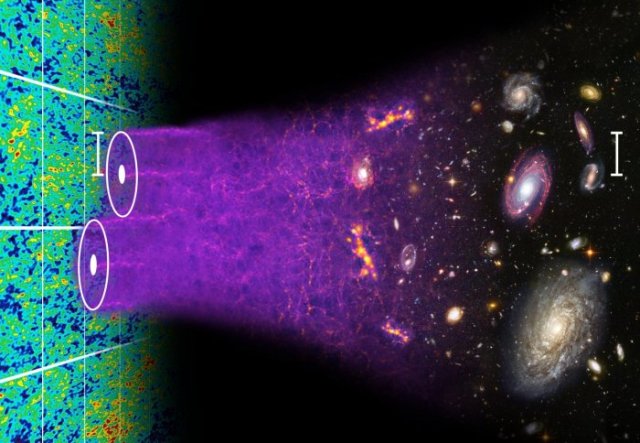Dec 15 2014
For the first time researchers have measured large distances in the Universe using data, rather than calculations related to general relativity.
 Illustration of the concept of Baryonic Acoustic. Oscillations. Credit: Chris Blake & Sam Moorfield
Illustration of the concept of Baryonic Acoustic. Oscillations. Credit: Chris Blake & Sam Moorfield
A research team from Imperial College London and the University of Barcelona has used data from astronomical surveys to measure a standard distance that is central to our understanding of the expansion of the universe.
Previously the size of this ‘standard ruler’ has only been predicted from theoretical models that rely on general relativity to explain gravity at large scales. The new study is the first to measure it using observed data. A standard ruler is an object which consistently has the same physical size so that a comparison of its actual size to its size in the sky will provide a measurement of its distance to earth.
“Our research suggests that current methods for measuring distance in the Universe are more complicated than they need to be,” said Professor Alan Heavens from the Department of Physics, Imperial College London who led the study. “Traditionally in cosmology, general relativity plays a central role in most models and interpretations. We have demonstrated that current data are powerful enough to measure the geometry and expansion history of the Universe without relying on calculations relating to general relativity.
“We hope this more data-driven approach, combined with an ever increasing wealth of observational data, could provide more precise measurements that will be useful for future projects that are planning to answer major questions around the acceleration of the Universe and dark energy.”
The standard ruler measured in the research is the baryon acoustic oscillation scale. This is a pattern of a specific length which is imprinted in the clustering of matter created by small variations in density in the very early Universe (about 400,000 years after the Big Bang). The length of this pattern, which is the same today as it was then, is the baryon acoustic oscillation scale.
The team calculated the length to be 143 Megaparsecs (nearly 480 million light years) which is similar to accepted predictions for this distance from models based on general relativity.
Published in Physical Review Letters, the findings of the research suggest it is possible to measure cosmological distances independently from models that rely on general relativity.
Einstein’s theory of general relativity replaced Newton’s law to become the accepted explanation of how gravity behaves at large scales. Many important astrophysics models are based on general relativity, including those dealing with the expansion of the Universe and black holes. However some unresolved issues surround general relativity. These include its lack of reconciliation with the laws of quantum physics and the need for it to be extrapolated many orders of magnitude in scales in order to apply it in cosmological settings. No other physics law have been extrapolated that much without needing any adjustment so its assumptions are still open to question.
Co-author of the study, Professor Raul Jimenez from the University of Barcelona said: “The uncertainties around general relativity have motivated us to develop methods to derive more direct measurements of the cosmos, rather than relying so heavily on inferences from models. For our study we only made some minimal theoretical assumptions such as the symmetry of the Universe and a smooth expansion history.”